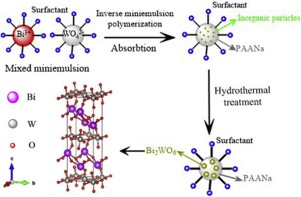当前位置:
X-MOL 学术
›
Colloids Surf. A Physicochem. Eng. Aspects
›
论文详情
Our official English website, www.x-mol.net, welcomes your
feedback! (Note: you will need to create a separate account there.)
Preparation, crystallization and properties of Bi2WO6 nanoparticles
Colloids and Surfaces A: Physicochemical and Engineering Aspects ( IF 4.9 ) Pub Date : 2020-04-01 , DOI: 10.1016/j.colsurfa.2020.124493 Zhenqian Zhang , Yongzhou Lin , Fang Liu
Colloids and Surfaces A: Physicochemical and Engineering Aspects ( IF 4.9 ) Pub Date : 2020-04-01 , DOI: 10.1016/j.colsurfa.2020.124493 Zhenqian Zhang , Yongzhou Lin , Fang Liu

|
Abstract Bismuth tungstate (Bi2WO6)-sodium polyacrylate (PAANa) latex particles were prepared by inverse miniemulsion and hydrothermal treatment. The effects of Bi(NO3)3/Na2WO4 dosage ratio and different hydrothermal treatment conditions on the particle size and morphology of Bi2WO6-PAANa latex particles were studied. The results show that the stability of the inverse microemulsion droplets was effectively improved with the increase of the soluble salt in the inverse microemulsion system, and the effect of different hydrothermal treatment on the particle size of the colloidal particles was not significant. During the formation of Bi2WO6 nanoparticles, PAANa latex particles could become a reaction site for forming Bi2WO6 nanoparticles, and Bi2WO6 nanoparticles were dispersed in the polymer. The effects of different hydrothermal treatment conditions on the size, crystal form and light absorption properties of Bi2WO6 nanocrystals were studied. The results show that Bi2WO6 nanoparticles with orthorhombic tungsten-rhenium ore structure could be prepared under different hydrothermal treatment conditions; moreover, the temperature at which the hydrothermal treatment forms the lowest Bi2WO6 nanocrystals was 130 °C. But at pH 9, the product was no longer pure phase. The prepared nanocrystals simultaneously exhibited strong ultraviolet-visible absorption characteristics and luminescence intensity. Finally, the Bi2WO6 nanoparticles with photoluminescence properties could be successfully prepared by the inverse miniemulsion method.
中文翻译:

Bi2WO6纳米颗粒的制备、结晶及性能
摘要 采用反相细乳液和水热处理法制备了钨酸铋(Bi2WO6)-聚丙烯酸钠(PAANa)胶乳颗粒。研究了Bi(NO3)3/Na2WO4用量比和不同水热处理条件对Bi2WO6-PAANa胶乳颗粒粒径和形貌的影响。结果表明,随着反相微乳体系中可溶性盐的增加,反相微乳液滴的稳定性得到有效提高,不同水热处理对胶体颗粒粒径的影响不显着。在Bi2WO6纳米粒子的形成过程中,PAANa乳胶粒子成为形成Bi2WO6纳米粒子的反应位点,Bi2WO6纳米粒子分散在聚合物中。研究了不同水热处理条件对Bi2WO6纳米晶尺寸、晶型和光吸收性能的影响。结果表明,在不同的水热处理条件下,可以制备具有正交钨铼矿结构的Bi2WO6纳米颗粒;此外,水热处理形成最低 Bi2WO6 纳米晶体的温度为 130 °C。但在 pH 值为 9 时,产物不再是纯相。制备的纳米晶体同时表现出强烈的紫外-可见吸收特性和发光强度。最后,通过反相细乳液法成功制备了具有光致发光特性的Bi2WO6纳米颗粒。结果表明,在不同的水热处理条件下,可以制备具有正交钨铼矿结构的Bi2WO6纳米颗粒;此外,水热处理形成最低 Bi2WO6 纳米晶体的温度为 130 °C。但在 pH 值为 9 时,产物不再是纯相。制备的纳米晶体同时表现出强烈的紫外-可见吸收特性和发光强度。最后,通过反相细乳液法成功制备了具有光致发光特性的Bi2WO6纳米颗粒。结果表明,在不同的水热处理条件下,可以制备具有正交钨铼矿结构的Bi2WO6纳米颗粒;此外,水热处理形成最低 Bi2WO6 纳米晶体的温度为 130 °C。但在 pH 值为 9 时,产物不再是纯相。制备的纳米晶体同时表现出强烈的紫外-可见吸收特性和发光强度。最后,通过反相细乳液法成功制备了具有光致发光特性的Bi2WO6纳米颗粒。产物不再是纯相。制备的纳米晶体同时表现出强烈的紫外-可见吸收特性和发光强度。最后,通过反相细乳液法成功制备了具有光致发光特性的Bi2WO6纳米颗粒。产物不再是纯相。制备的纳米晶体同时表现出强烈的紫外-可见吸收特性和发光强度。最后,通过反相细乳液法成功制备了具有光致发光特性的Bi2WO6纳米颗粒。
更新日期:2020-04-01
中文翻译:

Bi2WO6纳米颗粒的制备、结晶及性能
摘要 采用反相细乳液和水热处理法制备了钨酸铋(Bi2WO6)-聚丙烯酸钠(PAANa)胶乳颗粒。研究了Bi(NO3)3/Na2WO4用量比和不同水热处理条件对Bi2WO6-PAANa胶乳颗粒粒径和形貌的影响。结果表明,随着反相微乳体系中可溶性盐的增加,反相微乳液滴的稳定性得到有效提高,不同水热处理对胶体颗粒粒径的影响不显着。在Bi2WO6纳米粒子的形成过程中,PAANa乳胶粒子成为形成Bi2WO6纳米粒子的反应位点,Bi2WO6纳米粒子分散在聚合物中。研究了不同水热处理条件对Bi2WO6纳米晶尺寸、晶型和光吸收性能的影响。结果表明,在不同的水热处理条件下,可以制备具有正交钨铼矿结构的Bi2WO6纳米颗粒;此外,水热处理形成最低 Bi2WO6 纳米晶体的温度为 130 °C。但在 pH 值为 9 时,产物不再是纯相。制备的纳米晶体同时表现出强烈的紫外-可见吸收特性和发光强度。最后,通过反相细乳液法成功制备了具有光致发光特性的Bi2WO6纳米颗粒。结果表明,在不同的水热处理条件下,可以制备具有正交钨铼矿结构的Bi2WO6纳米颗粒;此外,水热处理形成最低 Bi2WO6 纳米晶体的温度为 130 °C。但在 pH 值为 9 时,产物不再是纯相。制备的纳米晶体同时表现出强烈的紫外-可见吸收特性和发光强度。最后,通过反相细乳液法成功制备了具有光致发光特性的Bi2WO6纳米颗粒。结果表明,在不同的水热处理条件下,可以制备具有正交钨铼矿结构的Bi2WO6纳米颗粒;此外,水热处理形成最低 Bi2WO6 纳米晶体的温度为 130 °C。但在 pH 值为 9 时,产物不再是纯相。制备的纳米晶体同时表现出强烈的紫外-可见吸收特性和发光强度。最后,通过反相细乳液法成功制备了具有光致发光特性的Bi2WO6纳米颗粒。产物不再是纯相。制备的纳米晶体同时表现出强烈的紫外-可见吸收特性和发光强度。最后,通过反相细乳液法成功制备了具有光致发光特性的Bi2WO6纳米颗粒。产物不再是纯相。制备的纳米晶体同时表现出强烈的紫外-可见吸收特性和发光强度。最后,通过反相细乳液法成功制备了具有光致发光特性的Bi2WO6纳米颗粒。





















































 京公网安备 11010802027423号
京公网安备 11010802027423号